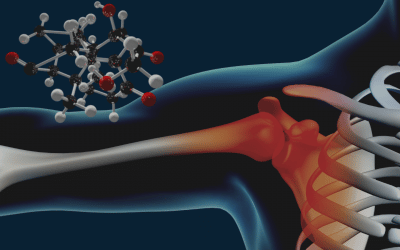AC Joint Degeneration is a condition that refers to the deterioration of the acromioclavicular (AC) joint. This joint is located at the top of the shoulder where the clavicle (collarbone) meets the acromion (bone of the shoulder blade). AC Joint Degeneration is also known as osteoarthritis of the AC joint.
AC Joint Degeneration most commonly affects middle-aged and older adults. However, the condition can also occur in younger adults, particularly those who participate in contact sports or other activities that put repetitive stress on the shoulder. In this article we will explore AC Joint Degeneration, what causes deterioration of the acromioclavicular joint and what treatment options are available.
What is the AC Joint?
What we often refer to as our shoulder is actually a complex of four separate joints. The Acromioclavicular Joint or AC Joint is formed where the outer end of the collarbone or clavicle meets the acromion, a bony process on the scapula bone. The AC Joint attaches the scapula to the clavicle and is therefore the primary connection that suspends the upper limb from the trunk.
Several strong ligaments surround the AC Joint and work together to provide stability and maintain the alignment of the joint. The bony surfaces of the distal clavicle and the acromion are lined with joint cartilage and the joint capsule contains joint fluid to keep things moving smoothly. Some people have a small joint disc made up of fibrocartilage, similar to the meniscus found in the knee joint.
What is the function of the AC Joint?
The AC Joint is not as highly mobile as the Glenohumeral Joint (the ball and socket jointThe glenohumeral joint is a ball-and-socket synovial joint and is the most mobile joint in the human More we often refer to as the shoulder) but it serves a few important functions:
- It allows the scapula to rotate and tip on the thorax.
- It allows for transmission of forces from the upper limb to the clavicle.
The AC Joint is hard at work whenever you move your upper limb through its range of motion, think of throwing, serving in tennis, push-ups and any other demanding movement of the arm and shoulder.
What causes AC joint degeneration?
The AC Joint is relatively small, but it still needs to deal with significant forces. In other words, we subject our AC Joints to large forces per unit area compared to our other joints. Unfortunately, this means that the AC Joint is extremely susceptible to trauma (often because of sporting injuries) and degenerative change.
Primary osteoarthritis refers to joint degeneration that occurs with no underlying cause. It develops because of constant stress on the joint over a period of many years, often in people who perform repeated overhead lifting activities. Degenerative change refers to the gradual thinning and destruction of the joint cartilage to where the joint becomes osteoarthritic and painful. Degenerative change can occur as early as the 2nd decade but is very common and almost universal by the 6th decade.
Secondary osteoarthritis occurs because of a traumatic injury or an underlying inflammatory condition like rheumatoid arthritis. In a traumatic injury, a sudden abnormal force separates or dislocates the joint. Besides being extremely painful, these injuries raise the risk for later degenerative change.
What are the symptoms of AC joint degeneration?
The primary symptom of AC Joint degeneration is pain. The pain is often felt at the top of the shoulder and provoked by overhead movements or sleeping on the affected shoulder. Sometimes there is some swelling or redness on top of the shoulder. Popping, clicking, or grinding sensations may be felt as the damaged cartilage surfaces move against one another. The AC Joint may be tender to the touch and even feel a little warmer than the surrounding area.
Your sports physician will make the diagnosis by performing a clinical examination and perhaps ordering imaging tests such as x-rays, ultrasound scans, or even an MRI.
How is AC joint degeneration treated?
Physiotherapy and activity modification
Physiotherapy is essential to manage pain, maintain the joint range of motion, strengthen stabilising muscles, and correct postural issues. Physiotherapy may include manual therapy, electro-modalities and exercise prescription.
Activity modification helps to avoid stressing the joint further and worsening the symptoms. Your physio will advise you to avoid push-ups, dips, flies, bench-press, and any repetitive overhead activities.
Oral analgesia
Pain-killing medications like non-steroidal anti-inflammatory drugs (NSAIDs) can diminish the pain from ACJ degeneration but have side-effects to consider.
Local corticosteroid injection
Your doctor will inject a mix of cortisone and local anaesthetic directly into the joint, usually under the guidance of an ultrasound scan. Corticosteroid injections can provide good pain relief but are ineffective in the long term. The pain usually comes back over a period of weeks to months.
Surgery
Surgical treatment is reserved for those severe cases that do not respond to at least six months of conservative treatment. Surgery can be done as an open or arthroscopic procedure (“keyhole surgery”). Arthroscopic procedures are generally associated with less pain and a faster return to function.

